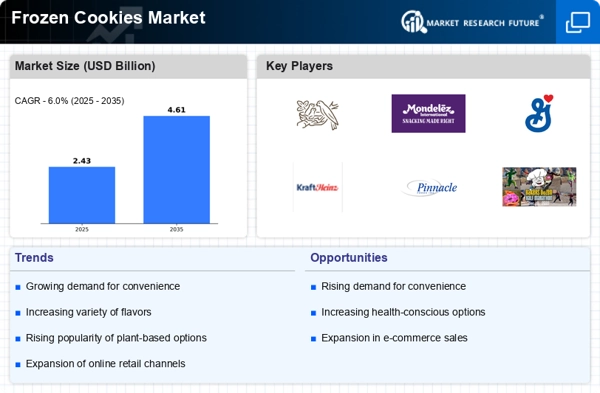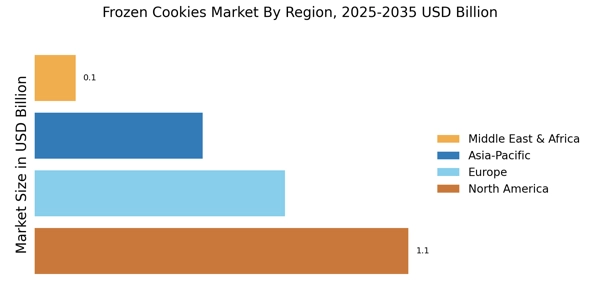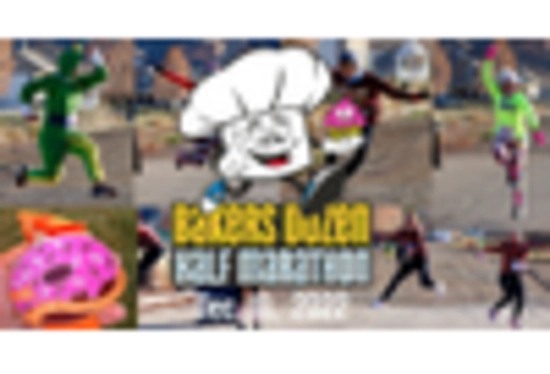E-Commerce Expansion
The Frozen Cookies Market is benefiting from the rapid growth of e-commerce platforms, which provide consumers with convenient access to a wide range of frozen cookie products. Online shopping has become increasingly popular, particularly for food items, as it allows consumers to explore various brands and flavors from the comfort of their homes. Recent statistics indicate that online grocery sales are expected to grow by 20% annually, significantly impacting the Frozen Cookies Market. This trend not only facilitates greater product visibility but also enables manufacturers to reach a broader audience, thereby driving sales and market penetration. The convenience of home delivery further enhances the attractiveness of frozen cookies, making them a preferred choice for many.
Diverse Flavor Profiles
The Frozen Cookies Market is witnessing a notable expansion in flavor innovation, catering to the evolving tastes of consumers. Manufacturers are increasingly introducing a variety of flavors, ranging from classic chocolate chip to exotic combinations like matcha and salted caramel. This diversification not only attracts a broader customer base but also encourages repeat purchases. Market data suggests that products with unique flavor profiles can command higher price points, thereby enhancing profitability for manufacturers. As consumers become more adventurous in their culinary choices, the demand for innovative frozen cookie flavors is likely to continue growing, positioning the Frozen Cookies Market for sustained success.
Health and Wellness Trends
The Frozen Cookies Market is adapting to the rising health consciousness among consumers. There is a growing demand for healthier alternatives, such as cookies made with whole grains, reduced sugar, and natural ingredients. This shift is reflected in market data, which indicates that products labeled as 'healthier' are experiencing increased sales, with a projected growth rate of 4.5% in the next few years. As consumers become more aware of nutritional content, manufacturers are reformulating their products to meet these demands, thereby expanding their market share. The incorporation of functional ingredients, such as protein and fiber, into frozen cookies is likely to further enhance their appeal within the Frozen Cookies Market.
Sustainability Initiatives
The Frozen Cookies Market is increasingly influenced by sustainability trends, as consumers become more environmentally conscious. There is a growing expectation for brands to adopt sustainable practices, including eco-friendly packaging and responsible sourcing of ingredients. Market Research Future indicates that products marketed as sustainable can see a price premium, with consumers willing to pay more for environmentally friendly options. This shift is prompting manufacturers within the Frozen Cookies Market to innovate in their packaging solutions and ingredient sourcing, aligning with consumer values. As sustainability becomes a key purchasing factor, companies that prioritize these initiatives are likely to gain a competitive edge in the market.
Convenience and Time-Saving
The Frozen Cookies Market is experiencing a surge in demand due to the increasing preference for convenience among consumers. Busy lifestyles have led to a growing inclination towards ready-to-eat products, with frozen cookies offering a quick and easy solution for snacks and desserts. According to recent data, the frozen dessert segment, which includes cookies, is projected to grow at a compound annual growth rate of 5.2% over the next five years. This trend indicates that consumers are seeking products that require minimal preparation time, thus driving the growth of the Frozen Cookies Market. Additionally, the ability to store frozen cookies for extended periods without compromising quality further enhances their appeal, making them a staple in many households.


















Leave a Comment